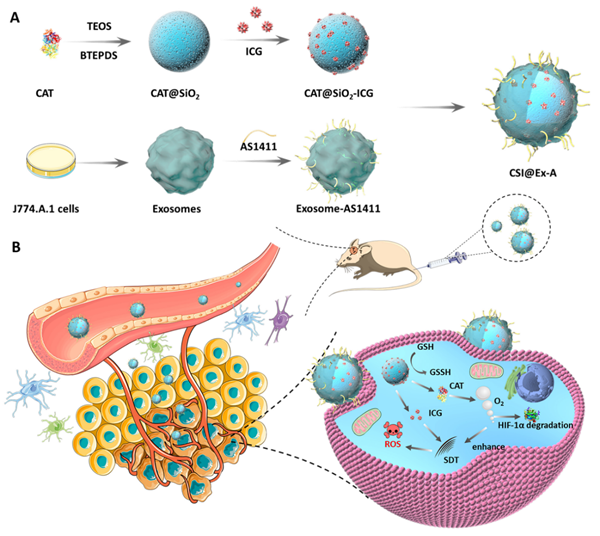Research Team of Hubei University Achieved Precise Sonodynamic Therapy for Gliomas
Author: School of Chemistry and Chemical Engineering Editor:Xian Wentao
Source: School of Chemistry and Chemical Engineering Released on: 2022/02/08
The latest research results of Professor Liu Zhihong's team in the school of chemistry and chemical engineering, “Engineering Macrophage Exosome Disguised Biodegradable Nanoplatform for Enhancedsonodynamic Therapy of Glioblastoma”, has recently been published in Advanced Materials(DOI:10.1002/adma.202110364, IF:30.8). Tingting Wu, postdoctoral fellow of the College of Chemistry and Chemical Engineering, is the first author of the paper, and Associate Professor Cao Yu and Professor Liu Zhihong are the corresponding authors.
Glioma is a serious disease of central nervous system that endangers human health. As the result of its high degree of malignancy, strong invasiveness and high postoperative recurrence rate, patients with glioma are subject to a median survival time of 15 months or so, less than 6% of who can live 5 years. Meanwhile, the traditional treatments of glioma, including surgical resection, chemical therapy and radiotherapy, is defective in high postoperative recurrence rate, low accuracy and serious side effects, etc. In addition, the new treatments developed in recent years, such as photodynamic therapy (PDT)/ photothermal therapy (PTT), immunotherapy and so on, have rather limited effect on curing human gliomas, as the biggest challenge lies in the fact that the blood brain barrier (BBB) severely restricts the brain delivery efficiency of therapeutic drugs or reagents. Blood brain barrier is the natural biological barrier of the brain, which is able to prevent more than 98% of exogenous small molecules and almost all nano-scale substances from entering brain parenchyma. Therefore, the primary problem to treat gliomas is how to efficiently penetrate the BBB with nano/molecular drugs and accurately identify glioma. Besides, photodynamic therapy possesses features as insufficient oxygen concentration in solid tumor tissue and overexpression of glutathione (GSH), etc., making some sonodynamic therapies that rely on reactive oxygen species to kill cancer cells much less effective. 
Figure 1. Schematic diagram of biomimetic nanocarriers for sonodynamic therapy of glioma
该工作构建了谷胱甘肽响应的纳米载体有效封装过氧化氢酶(catalase, CAT)并负载声敏剂吲哚菁绿(Indocyanine green, ICG)。
To solve the above problems, the research team has developed varieties of strategies to overcome the difficulty of crossing the blood-brain barrier in brain delivery and has achieved innovative results in this field, publishing a number of papers with relevant research results in journals like Anal. Chem.,ACS Nano.,Adv. Funct. Mater., etc. (Adv. Funct. Mater. 2020, 30, 1909369, Anal. Chem. 2020, 92, 5569, ACS Nano 2021, 15, 11940-11952). Recently, on the basis of previous research, the research team modified biodegradable nanodrug carriers with engineering macrophage-derived exosomes, achieving precise sonodynamic therapy (SDT) for glioma. In this work, a glutathione responsive nanocarriers are constructed to effectively encapsulate catalase (CAT) and load the sonosensitizer of indocyanine green (ICG). Exosome modification can effectively enrich the nanocarriers in the glioma and respond to the high expressed glutathione in tumor cells, thus realizing the effective release of catalase and indocyanine green at the target site as well as the sonodynamic therapy with enhanced oxygen self-supply. At the same time, it consumes glutathione, further destroys the redox equilibrium in tumor cells and boosts the effect of sonodynamic therapy.
This study broke through the bottleneck of the application of sonodynamic therapy in the treatment of glioma and realized its effective performance, providing new ideas and methods for the clinical transformation of sonodynamic therapy for glioma.
(Reviewed by: Zhang Xiuhua)